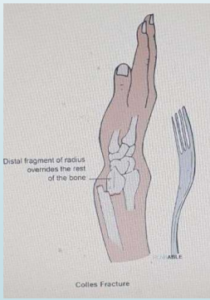D. Dinner fork deformity – Explanation
Results from fall on an outstretched hand, often in old osteoporotic women. The
deformed and painful wrist looks like a “dinner fork”. The main lesion is a dorsally
displaced, dorsally angulated fracture of the distal radius.
COLLES
Results from fall on an outstretched hand, often in old osteoporotic women. The
deformed and painful wrist looks like a “dinner fork,”. The main lesion is a dorsally
displaced, dorsally angulated fracture of the distal radius.
Management
Involves providing analgesia, reduction and immobilize in a backslab POP and elevate
with a sling. This is usually done by an A&E doctor at initial presentation. It is good
practice to obtain an X-ray before and after the reduction to ensure that reduction was
successful. During reduction, analgesia such as a haematoma block is usually
administered. A haematoma block is an analgesic technique where local anaesthetic
(i.e. lidocaine) is inserted by needle and syringe through the skin into this haematoma
where the fracture site is, allowing bones to be painlessly manipulated back.
Once closed manipulation has taken place, a backslab POP is applied while still holding
the wrist in place. The POP is left to dry. A post reduction X-ray is required to ensure
that reduction was successful. If successful and fracture is nondisplaced, patients are
discharged to be managed back home with a fracture clinic follow-up.



